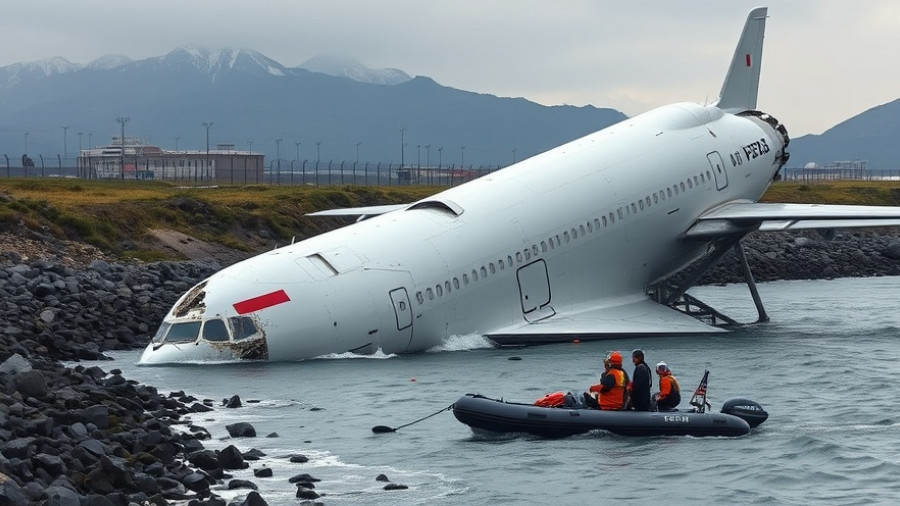
Tragedy Strikes: A Cargo Plane Accident in Hong Kong
In a stark reminder of the inherent dangers of air transport, a cargo aircraft skidded off a runway at Hong Kong International Airport on Monday, October 20, 2025, resulting in a tragic loss of life. The Boeing 747 freighter, operating under the airline ACT Airlines and wet-leased from Emirates, was on a routine landing from Dubai when it veered off course around 3:50 AM. First responders confirmed that two airport ground crew members tragically lost their lives when their service vehicle was struck during the accident.
What Happened on That Fateful Morning?
According to eyewitness accounts and initial reports from local authorities, the aircraft, designated as flight EK9788, was traveling at an alarming speed of approximately 90 knots upon touchdown. As it touched down on the runway, it deviated to the left, ultimately crashing into the waters adjacent to the airport’s sea wall. Rescue efforts were promptly initiated, leading to the safe recovery of the four crew members onboard, but the fate of the two ground crew members was still uncertain initially. Unfortunately, they were later confirmed dead, with one pronounced dead at the scene and the other succumbing to injuries at North Lantau Hospital.
The Role of the Airline
Emirates, known for its extensive long-haul passenger services and thriving cargo business, played a crucial role in this incident, as the aircraft involved was wet-leased under their operations to meet surging cargo demands. The company issued a statement noting that there was no cargo on board during the flight, placing the emphasis on safety and recovery operations in the aftermath of the crash. It’s worth noting that wet-leases involve a complex arrangement where the operating airline provides not only the aircraft but also the crew and maintenance, making the operational oversight paramount.
Immediate Aftermath and Airport Response
The Hong Kong Airport Authority's response was swift. Following the crash, the north runway was closed to allow for recovery operations and investigation, while the south and central runways remained open, minimizing disruptions for other flights. Initial reporting indicated that the crash did not affect airport operations significantly; however, a considerable investigation was set in motion by the Civil Aviation Department of Hong Kong to identify the causes of this tragic accident.
Understanding the Impact of Wet Leasing
The concept of wet leasing is significant in the aviation industry, especially for airlines looking to expand their capacity without the expense of purchasing aircraft outright. In this case, Emirates had added two Boeing 747s to its fleet to meet increased demand. While partnerships of this nature can enhance operational flexibility, they also introduce layers of complexity regarding operational standards and accountability. This event may lead to a critical reassessment of the protocols surrounding wet leases, particularly concerning crew training and emergency response procedures.
Looking Forward: What Can We Learn?
The crash of flight EK9788 serves as a significant case study in the aviation industry. First and foremost, it highlights the importance of stringent safety protocols and thorough operational checks, especially in the realm of wet-leased aircraft. As investigations continue, it’s vital for the aviation community to draw lessons that will enhance safety features and measures. Understanding the aviation dynamics and response mechanisms can pave the way for improved safety standards which may prevent future incidents.
Final Thoughts: Community and Aviation Safety
For those living in Central Florida and indeed for travelers globally, this incident is a stark reminder of the risks associated with air travel. It underscores the importance of community support in times of tragedy, as well as the ongoing need for airlines and airports to prioritize public safety amidst operational pressures. The emotional toll of such incidents can resonate deeply with the families affected, raising important conversations about the balance between operational efficiency and the sanctity of human life.
This tragedy not only reminds us of the vulnerabilities within the aviation sector but also calls upon the community and relevant stakeholders to advocate for safety reforms. In light of this accident, locals and travelers alike are encouraged to engage in conversations around aviation safety measures to ensure that such losses are not repeated in the future.
 Add Row
Add Row  Add
Add 




Write A Comment